Download and print as a PDF (1MB pdf)
On this page
- How does our hearing work?
- How does aiding help with hearing loss?
- How do I maintain my hearing aids?
- How do I put in my hearing aids?
- How do I retube my ear mould?
- How do I find a fault with my hearing aid?
- How do I access repair services?
- Where can I get batteries from?
- Who do I contact for assistive equipment in Sussex?
- How can I use the telephone with a hearing aid?
- How do I use the loop system?
- Where can I access equipment sessions?
- Can I have hearing therapy?
- How do I access interpreting services for BSL users?
- Are there any tactics for good communication?
- Can I get assistance with travel?
- Can I register as hearing impaired with my local council?
- Which organisations can be useful?
- Who do I contact for further appointments?
How does our hearing work?
Sound waves enter the ear and travel down to the ear drum. The sound waves make the ear drum vibrate, like a drum. This in turn makes three tiny connected bones (the ossicles-malleus, incus, stapes) in the space behind the ear drum vibrate. Beyond these three bones is the inner ear or cochlea, which consists of thousands of tiny hair cells like a rolled up piano keyboard. These cells sense the sound vibrations and convert them into nerve signals. The brain makes sense of these signals and this is how we hear.
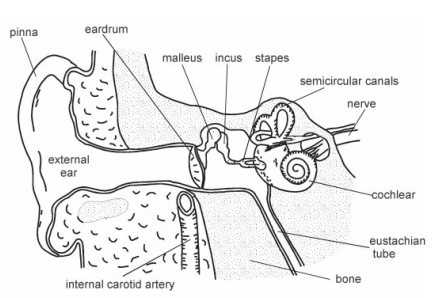
How does aiding help with hearing loss?
Hearing loss is common – it affects 12 million people in the UK.
There are 3 types of hearing loss:
Conductive – Where sound is not passed properly from the ear drum to the inner ear (e.g. due to wax or middle ear congestion).
Sensorineural – Where the cause of the hearing loss is the inner ear e.g. the cochlea or hearing (auditory) nerve.
Mixed – a combination of both conductive and sensorineural.
Sensorineural hearing loss is the type of hearing loss many people experience with increasing age. It tends to occur gradually so people often don’t realise that their hearing is getting worse. High pitched sounds are more likely to be affected than low pitches. This type of hearing loss often reduces the quality of the sound as well as its loudness.
If this is the reason for your hearing loss, the first signs you may notice are that people’s speech is muffled or they seem to mumble. You may also have difficulty hearing conversation when you are in a group. These difficulties can lead to frustration and tension for both you and your family and friends.
A hearing aid can help. However, a hearing aid will not cure your hearing loss. It can only amplify the hearing you still have. It will not give you back the hearing you have lost.
A hearing aid is not a ‘quick-fix’ solution – it takes time, practice and perseverance. You will not get the full benefit of a hearing aid if you do not use it regularly. The more you wear your hearing aid the more benefit you will get. Wear it even in situations where you do not think you need to – it is easier to start to practice in quiet environments. At first, your own voice may sound a bit different but you will soon get used to this.
Remember that your brain has become used to not hearing many sounds and will take time to adjust to any new situations. It is normal to hear sounds you have forgotten. These sounds have always been there and with time you will re-learn to filter them out again.
Sections 3, 4 and 5 of this booklet explain hearing aids, hearing aid maintenance, how to put your hearing in and how to find a fault with your hearing aid. This information can also be found in these videos at C2hear.
How do I maintain my hearing aids?
Your hearing aid consists of two parts:

The ear mould is the part that fits into your ear and can be made of different types of material, ranging from hard acrylic to soft silicon, or it can be a thin tube. The type of material that is chosen depends on various factors, including your hearing loss. Often, the greater the hearing loss, the fuller the ear mould.
The hearing aid itself attaches to the mould by the tubing. The hearing aid could have a volume control and program button. Most hearing aids turn off by disconnecting the battery drawer See the manufacturer’s manual for more information on your specific hearing aid.
Cleaning
You should clean your ear mould with a damp cloth or antibacterial wipe when you take it out at night. Check that the tubing is not blocked with wax or moisture. Please note, however, that getting the hearing aid very wet will permanently damage it.
Retubing
Your ear mould needs to be retubed every six months. We will show you how to do this or it could be done in a repair appointment. If you have the ‘open fit’ style of hearing aid, then the tube also needs to be changed about every six months. Should the dome come off the tubing, you should never attempt to replace it – instead, use a new tube and dome as provided by us.
Storing
After a day’s use, there can be some build-up of moisture in the hearing aid and tube. When not in use and at night, open the battery drawer and leave the hearing aid in a dry place to air out. Avoid extreme heat or cold.
How do I put in my hearing aids?
Mould fit
It is important to insert the mould into your ear correctly to prevent feedback (whistling), soreness of the ear or loss of the hearing aid. The correct insertion is demonstrated in the pictures below.
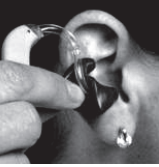
Hold the ear mould by the curved edge and place the tip of the mould into the ear canal.
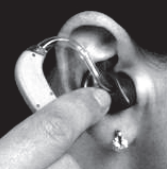
Twisting slightly, make sure that the top part of the ear mould is pushed under the crease at the top of your ear. This is the most common area to make a mistake.
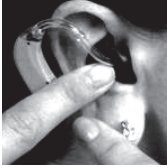
Use the other hand to pull down your earlobe. Push your ear mould firmly in.
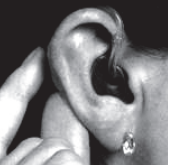
With the ear mould correctly positioned in your ear, place the hearing aid behind your ear.
Open fit
It is important to insert the tube correctly into the ear to stop the hearing aid from whistling or falling out. The correct insertion is demonstrated in the pictures below. Should the dome come off the tubing, you should never attempt to replace it – instead, use a new tube and dome as provided by us.
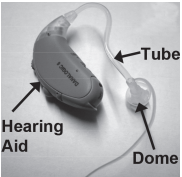
This picture shows the different parts of your hearing aid. The dome goes down into your ear and the hearing aid sits behind.
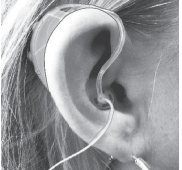
Place the Hearing aid behind the ear. Letting the tube and dome dangle in front of the ear.
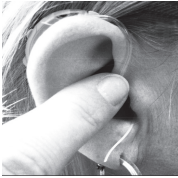
Push the dome in until the tube lies flat against your head. You may need to pull down on your ear lobe with the other hand to help.
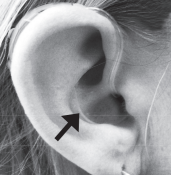
Tuck the retaining strip, if you have one, into the bowl of your ear to help keep the hearing aid in place.
How do I retube my ear mould?
1. Remove the old existing tubing with either your hand or pliers.

2. Using replacement tubing (which you can obtain from your Audiologist), taper the edge of one side using a pair of scissors. Do not cut too close to the bend.

3. Thread the tube into your earmould from the outside, through to the part that fits inside your ear.
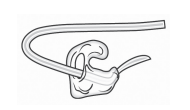
4. Next, pull the tubing through the earmould so that the remaining tubing is facing upwards at approximately a 50 degree angle.
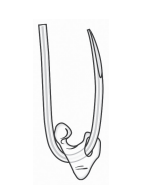
5. Using a sharp pair of scissors carefully cut the tapered tubing flush with the end.
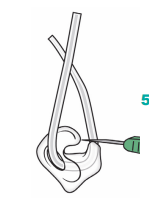
How do I find a fault with my hearing aid?
How do I access repair services?
Postal repair service
If your hearing aid is faulty, you can post it to the Audiology Department. Include a letter with a description of the fault and your battery card. Your hearing aid will then be repaired and returned to you by post. We will return your aid as quickly as possible.
Re-tubing services (drop in)
If you need new or replacement tubing for an ear mould, please feel free to visit one of our drop-in re-tubing services (marked with * on the following pages). These are staffed by trained volunteers.
Hearing aid repairs (by appointment)
If you need a repair to your hearing aid or ear mould, please contact the Audiology Department to arrange an appointment. We will be able to offer a booked hearing aid repair appointment within two working days at Sussex House. You can also be seen at County Oak Medical Centre, Mile Oak Medical Centre, Orchard House at Lewes Victoria Hospital and Princess Royal Hospital, but you might have to wait longer for an appointment.
Repair appointments are not for adjustments of hearing aids that are working well.
For this you will need to ask for a follow up appointment.
Where can I get batteries from?
You can get new batteries from a clinic in your area. We also supply batteries and by post – just send your battery card to us.
Brighton
- Age Concern (near Seven Dials)
29-31 Prestonville Road, BN1 3TJ - County Oak Medical Centre
Carden Hill, BN1 8DD - Moulsecoombe Clinic
Hodshrove Lane, BN2 4SE - Sussex House
Abbey Road, Brighton,
BN2 1ES
Re-tubing service every Tuesday 10am until 12 noon
Age Concern
01273 720603
County Oak Medical Centre
01273 545922
Moulsecoombe Clinic
01273 260010
Lewes
- Outpatients Department
Lewes Victoria Hospital
Neville Road
BN7 1PE - Hearing & Maintenance support
group
House of Friendship
208 High Street
Lewes BN7 2NS
Outpatients Department
01273 402508
Hearing & Maintenance support group
01273 476469
Hearing & Maintenance support group, 3rd Wednesday of every month. (run by East Sussex hearing resource centre – 01323 722505)
10:30 am to 12:00 pm
East Sussex Hearing Resource Centre
01323 722505
Hove
- Charter Medical Centre
88 Davigdor Road, BN3 1RF - Knoll House
Ingram Crescent West
Portland Road, BN3 5NX - Hove Poly Clinic
Nevill Avenue, BN3 7HY
(Batteries only)
Charter Medical Centre
01273 738070
Knoll House
01273 267588
Hove Poly Clinic
01273 696011
Haywards Heath
- Outpatients Department
Princess Royal Hospital
Lewes Road, RH16 4EX - Haywards Heath Health Centre
Heath Road, RH16 3BB
Haywards Heath Health Centre
01444 414100
Newhaven
- Quayside Medical Practice
Chapel Street, BN9 9PW - Newhaven Polyclinic
Church Hill, BN9 9HH
Quayside Medical Practice
01273 615000
Newhaven Polyclinic
01273 511800
Who do I contact for assistive equipment in Sussex?
If you need help to hear the TV, phone, doorbell or smoke alarm, get in touch with your nearest centre.
Brighton and Hove
The Access Team,
3rd Floor, Barts House,
Bartholomew’s Square,
Brighton, BN1 1JE
Social Care & Health Access Point Telephone
01273 295555
Text
01273 296388
Email
[email protected]
East Sussex
- For an assessment contact:
The Sensory Team,
St Mary’s House,
52 St Leonards Road,
Eastbourne,
BN21 3UU - Demonstration of equipment available from Social Services or for purchase from suppliers:
East Sussex Hearing Resource Centre
8 St Leonards Road,
Eastbourne, BN21 3UH
Assessment Team Phone
0345 60 80 191
Text
07797 878111
Email
[email protected]
East Sussex Hearing Resource Centre
01323 722505
East Sussex Hearing Resource Centre
[email protected]
West Sussex
For an assessment contact:
Sensory Services Team,
County Hall North, Chartway,
Horsham, RH12 1XA.
Sensory Services Team phone
01243 642555
Text
07736 093462
Fax
01403 217671
Email
[email protected]
Demonstration of equipment available from Social Services (assessments available) or for purchase from shop:
Action for Deafness Haywards Heath
22 Sussex Road,
RH16 4EA
Telephone
01444 415582
Email
[email protected]
For support at work, you may be eligible to apply to the government scheme Access to Work. For details of funding routes available and to check eligibility, regardless of which hearing aids you use, visit the website.
How can I use the telephone with a hearing aid?
Using an ordinary phone with a hearing aid
- Place the telephone earpiece over or near the microphone area of the hearing aid
- On the majority of hearing aids this is positioned at the front of the hearing aid itself
- Do not put the phone over the ear as it has been ‘blocked’ with the ear mould
- Adjust the volume control on the hearing aid if available but be beware that the hearing aid may ‘whistle’ or ‘feedback’ if the volume is too high
Using an amplified phone with a hearing aid
- Press the ‘amplify’ button on the telephone (on some phones)
- Hold the phone over the hearing aid itself and move it until the best hearing position is found
- Adjust the volume control on the telephone as required. This may be a sliding bar or it may be a + and – button
- Some phones also have a tone control (Geemarc)
Using a speaker phone with a hearing aid
If you use the hands-free function of your phone you would have the benefit of hearing through both your hearing aids/ears.
Other useful tips
- Practise using a recorded message on the phone eg 1471 to make sure the phone is being held correctly
- Phone a friend and practise with them
- Build up your confidence before answering the phone
- If you have difficulty understanding the caller, tell them how they can help you, e.g.:
- Slow down
- Check they are holding the mouthpiece correctly
- Confirm the information in writing
- Consider subscribing to Caller Display or Privacy at Home (BT customers) which will show the number of the person who is calling you on a screen (you may need to have an extra piece of equipment)
- If you find nuisance or spam phone calls a problem, consider registering on the ‘Telephone Preference Service’ to prevent these callers contacting you. This is a free service and details can be found in the local telephone book. (NB This service may not be suitable for broadband users)
- Consider additional equipment – see below section
Extension bells
An extension bell could help you hear the telephone ring. BT will supply one extension bell free of charge for residential customers who are hard of hearing. Ideally this should be fitted in the hallway of the accommodation. If no telephone socket is available in the hallway BT will fit this without charge.
For phone adjustments, adapted phones or equipment
Connevans
Telephone
01737 247571
Action on Hearing Loss Shop
Action on Hearing Loss no longer sell equipment but will still offer impartial advice and make recommendations.
Telephone
01733 361199
Text
01733 238020
Email
[email protected]
How do I use the loop system?
When activated, the loop or telecoil setting on your hearing aid should make it easier to hear in public places, e.g. train station, bank, post office, church, theatre or cinema. Look out for the symbol with a T in the bottom right corner.

To use the loop system you will need to select the loop program in your hearing aids (if activated) – details of how to do this in your specific hearing aid can be found in the manufacturer’s leaflet.
Where can I access equipment sessions?
These sessions provide an opportunity to try out a range of equipment. The sessions are held on a monthly basis. Please contact Audiology Reception to book your place.
Amplified telephones
- Advice on using telephones with hearing aids
- Demonstration of amplified phones
Listening devices for
- TV
- Meetings
- Social situations
Alerting devices
- Alarm clock
- Doorbell
- Telephone Bell
- Smoke Alarm
Also further advice and information on other equipment.
Can I have hearing therapy?
You can be referred (by your Audiologist or GP) to see a Hearing Therapist in the department who could help with:
- Understanding your hearing loss
- Adjusting to using a hearing aid
- Advice and information on additional equipment e.g. for the TV, meetings, telephone, doorbell etc
- Coping strategies for dealing with problems at home, work and social situations
- Lipreading and other communication tactics
- Advice for family/friends
- Tinnitus – explanation, discussion and tactics
How do I access interpreting services for BSL users?
Are there any tactics for good communication?
If you are deaf or hard of hearing
- Have you thought about learning to lip-read? Everyone lip-reads to some extent, especially in noisy places
- Be open, tell the person you’re speaking to that you lip-read, before you start a conversation
- Ask people to get your attention before they start talking to you
- Do not stand too far away from the person who is speaking to you
- Try to keep calm and do not panic. If you become anxious or flustered, it might be harder for you to follow what is being said
- If your hearing is not the same in both ears, try turning your better side towards the person speaking to you
- If you do not catch what someone says first of all, do not be afraid to ask them to repeat it or say it in a different way
- If necessary, ask people to slow down and speak more clearly
- Do not be too hard on yourself. No one hears correctly all the time
- Make sure you can see the speaker’s face and lips. Their gestures and facial expressions will help you understand what they’re saying
- In a noisy place, move to a quieter area if possible. Position yourself how it suits you best to hear those you are talking to (this may be sitting in a corner or sitting with your back to most of the background noise, for instance)
If you are speaking to someone who has a hearing loss
- Even if someone is wearing a hearing aid, it does not mean that they can hear you. Ask if they need to lip-read you
- Make sure you have the listener’s attention before you start speaking
- Speak clearly but not too slowly, and do not exaggerate your lip movements
- Use natural facial expressions and gestures
- If you are talking to a deaf person and a hearing person, do not just focus on the hearing person
- Do not shout. It is uncomfortable for a hearing aid user and it looks aggressive
- If someone does not understand what you have said, do not just keep repeating it. Try saying it in a different way
- Find a suitable place to talk, with good lighting, away from noise and distractions
- Remember not to turn your face away from a deaf person. Always turn back to your listener so they can see your face
- Check that the person you are talking to can follow you. Be patient and take the time to communicate properly
- Use plain language and do not waffle. Avoid jargon and unfamiliar abbreviations
Lip Reading
To find classes in your area go to atlalipreading.org.uk and search ‘find a lipreading class’. Alternatively, do some online learning at: lipreadingpractice.co.uk. Lip reading classes within Sussex area (always check availability and book in advance):
Brighton and Hove
Action on Hearing Loss,
Community Base, 113 Queens Road,
Brighton, BN1 3XG.
Level: Mixed
3rd Wednesday each month (current waiting list)
1:00 pm to 2:30 pm
Telephone
01273 840960
Email
[email protected]
Haywards Heath
Action for Deafness,
22 Sussex Road, Haywards Heath,
RH16 4EA.
Contact/Tutor: Helen Smith
Level: Mixed
Monday
2:00 pm to 4:00 pm
Tuesday
10:00 am to 12:00 pm
Thursday
10:00 am to 12:00 pm
Telephone
01444 415582
Email
[email protected]
Lewes
House of Friendship,
208 High Street,
Lewes, BN7 2NS
Level: Mixed
Wednesday
10:00 am to 11:30 am
Telephone
01273 476469
Email
[email protected]
Can I get assistance with travel?
Railcards
Everyone that wears an NHS hearing device is eligible to apply for a Disabled Persons Railcard from National Rail. This provides discounted rail travel for a small annual fee.
Details and application forms are available from the Audiology reception or online at: www.disabledpersons-railcard.co.uk
Bus passes
Anyone that has a severe-profound hearing loss (70dB + loss) in the West Sussex, East Sussex and Brighton and Hove areas is entitled to a disabled person’s bus pass. You can apply online or via post. We can provide you with a copy of your audiogram.
East Sussex County Council
In person: Pick up a form from your local East Sussex library.
Telephone
0300 33 09 471
Can I register as hearing impaired with my local council?
Registering with your local council as hearing impaired can be beneficial for their data collection and service planning. To register, please contact your council by using the contact information below. We can provide a copy of your audiogram if required.
Brighton and Hove
Business Support Health and Adult Social Care
2nd Floor Bartholomew House
Bartholomew Square, Brighton,
BN1 1JE.
Telephone
01273 296380
Email
[email protected]
West Sussex
Adults’ CarePoint
Parkside/County Hall North, Third Floor,
Chartway, Horsham,
West Sussex,
RH12 1XH.
Telephone
01243 642121
Textphone
01403 275515
SMS
07736 093462
Fax
01403 217671
Email
[email protected]
East Sussex
Health and Social Care Connect
St. Mary’s House,
52 St Leonard’s Road,
Eastbourne, BN21 3UU.
Telephone
0345 60 80 191
Text
07797 878 111
Minicom via Typetalk
18001 0345 60
Email
[email protected]
Which organisations can be useful?
Hearing Link
Telephone
0300 111 1113
Hearing Like Me
Hear Together
Email
[email protected]
Deafblind UK
Telephone
0800 132320
Text
07950 008870
Text relay
18001 then 0800 132320
Facetime
[email protected] (not BSL)
Email
[email protected]
National Deaf Children’s Society Helpline
Telephone/text
0808 800880
Take on Tinnitus phone
0800 018 0527
Take on Tinnitus
Telephone
0800 018 0527
Hearing Aids for Music
Who do I contact for further appointments?
We recommend a reassessment of your hearing every three years. Please phone the Audiology department to book a reassessment appointment. Further appointments can be booked at any site where our clinics are based:
- Sussex House
- Royal Sussex County Hospital
- County Oak Medical Centre
- Mile Oak Medical Centre
- Orchard House at Lewes Victoria Hospital
- Princess Royal Hospital
If you are unable to attend or no longer need your appointment, please let us know as soon as possible by using the below contact details. We can then agree another date/time that is convenient for you or cancel the appointment if you no longer wish to be seen.
These appointments are in great demand and if you no longer require one please let us know as soon as possible so your time can be offered to another patient.
NHS hearing aids remain government property, provided on loan to patients though this department. If you lose your hearing aid, you will be charged for this loss.
The current fee is £72.00 per aid (including VAT).
This is not a charge for a replacement, but to cover the loss of NHS property.
The only exceptions to the charge are made for patients who fall within the following six categories:
- Patients on income Support
- Patient receiving universal credit …NB. Only if the UC monthly take-home pay is £435.00 or less or up to £935.00 with child responsibilities or limited capability for work
- Pensioners receiving Pension Credit
- People claiming disability benefit, including: attendance allowance or PIP awarded for daily living component, JSA
- Patients who have their hearing aids lost on NHS premises, including Ambulances
- Patients who report their hearing aids as stolen and produce a police crime number to support this.
If you feel that you belong within one of the six categories, you will need to provide documentary evidence of this fact. We will need to make a photocopy for our records. If you belong to more than one of these groups we will not need to see two sets of information
Please provide evidence to the Audiology department office within the next ten working days so that we can call a halt to the invoice that will otherwise automatically be raised by this trust
Today’s date
Patient signature
This information is intended for patients receiving care in Brighton & Hove or Haywards Heath.
The information in this leaflet is for guidance purposes only and is in no way intended to replace professional clinical advice by a qualified practitioner.